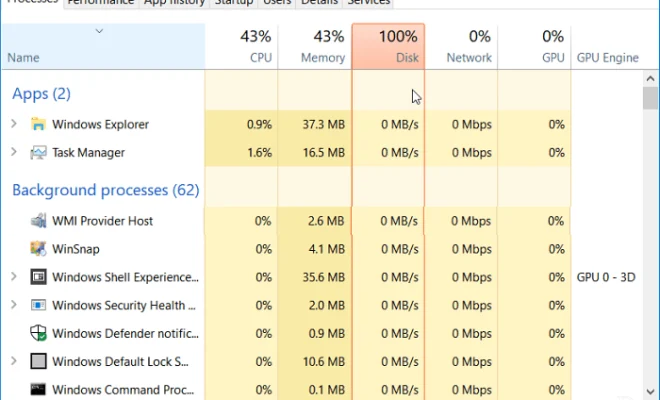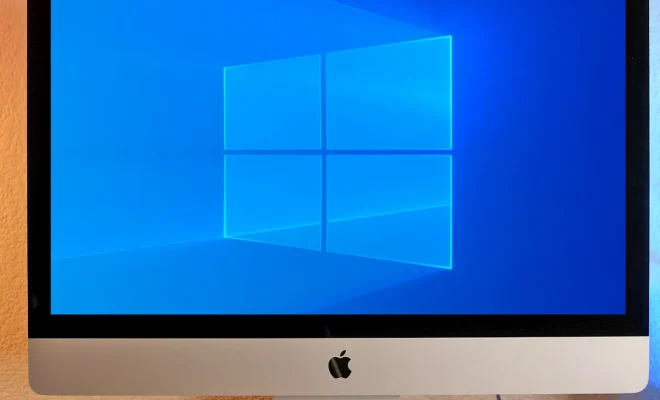100% Disk Usage in Windows 10? Tips and Tricks to Fix This Issue

If you are experiencing 100% disk usage in Windows 10, then you might be frustrated with how slow your computer is functioning. Fortunately, there are several tips and tricks that you can follow to fix this issue. In this article, we will explore 17 of them.
- Disable Windows Search Service: You can disable the Windows Search service to reduce disk usage. Press the Windows + R keys to open the Run dialog box. Type “services.msc” and click OK. Find “Windows Search” in the list of services, right-click it, and select “Properties.” Click “Stop” to stop the service and select “Disabled” as the startup type. Click OK to save the changes.
- Change Virtual Memory: You can change the virtual memory settings to reduce disk usage. Go to Control Panel > System and Security > System > Advanced System Settings > Performance > Settings > Advanced. Under “Virtual memory,” click “Change.” Uncheck “Automatically manage paging file size for all drives” and select the “Custom size” radio button. Set the initial size and maximum size, then click OK.
- Disable Superfetch: Superfetch is a Windows service that preloads frequently used applications into memory. However, it can also cause high disk usage. To disable Superfetch, press the Windows + R keys, type “services.msc,” and click OK. Find “Superfetch” in the list of services, right-click it, and select “Properties.” Click “Stop” to stop the service and select “Disabled” as the startup type. Click OK to save the changes.
- Disable Windows Tips and Tricks: Windows Tips and Tricks is a feature that provides helpful tips to users. However, it can also cause high disk usage. To disable Windows Tips and Tricks, go to Settings > System > Notifications & actions. Turn off “Get tips, tricks, and suggestions as you use Windows.”
- Uninstall Memory-Intensive Programs: Some programs consume a lot of memory, which can cause high disk usage. To determine which programs are causing this issue, go to Task Manager > Processes. Sort processes by “Disk” to see which programs are using the most disk resources. Uninstall any memory-intensive programs that you don’t need or use.
- Check for Viruses and Malware: Viruses and malware can cause high disk usage. To check for viruses and malware, use an antivirus or antimalware program. Perform a full system scan and remove any detected malware or viruses.
- Disable Antivirus Scans: Antivirus scans can cause high disk usage. To reduce disk usage during antivirus scans, schedule scans at a time when you are not using your computer. Alternatively, you can temporarily disable the antivirus during scans.
- Update Device Drivers: Outdated device drivers can cause high disk usage. To update device drivers, go to Device Manager, find the device that needs an update, right-click it, and select “Update driver.” You can also use a driver update software to update all your drivers automatically.
- Disable Windows Defender: Windows Defender is a built-in antivirus program in Windows 10. However, it can cause high disk usage. To disable Windows Defender, go to Settings > Update & Security > Windows Security. Click “Virus & threat protection,” then “Manage settings.” Turn off “Real-time protection” and “Cloud-delivered protection.”
- Clear Thumbnails Cache: Thumbnails cache can accumulate over time, causing high disk usage. To clear the thumbnails cache, go to Disk Cleanup > Clean up system files. Select “Thumbnails” and click OK.
- Disable Automatic Windows Updates: Automatic Windows updates can cause high disk usage. To disable automatic Windows updates, go to Settings > Update & Security > Windows Update > Advanced Options. Click “Pause updates for 7 days” or “Pause updates for 30 days.”
- Disable OneDrive Sync: OneDrive sync can cause high disk usage. To disable OneDrive sync, right-click the OneDrive icon in the system tray and select “Settings.” Click the “Account” tab and click “Unlink this PC.” This will stop OneDrive from syncing with your computer.
- Disable Background Apps: Background apps can cause high disk usage. To disable background apps, go to Settings > Privacy > Background apps. Turn off any apps that you don’t need running in the background.
- Adjust Power Settings: Power settings can cause high disk usage. To adjust power settings, go to Control Panel > Power Options. Select a power plan and click “Change plan settings.” Click “Change advanced power settings” and adjust settings under “Hard disk,” “Processor power management,” and “System cooling policy.”
- Run Disk Check: Disk errors can cause high disk usage. To run Disk Check, go to File Explorer, right-click the drive that you want to check, and select “Properties”. Click the “Tools” tab and click “Check” under “Error checking.”
- Adjust Indexing Options: Indexing can cause high disk usage. To adjust indexing options, go to Control Panel > Indexing Options. Click “Modify,” then uncheck any folders that you don’t need indexed.
- Reset Your PC: If all else fails, you can reset your PC to factory settings. Go to Settings > Update & Security > Recovery. Click “Get started” under “Reset this PC.” Follow the instructions to reset your PC.






